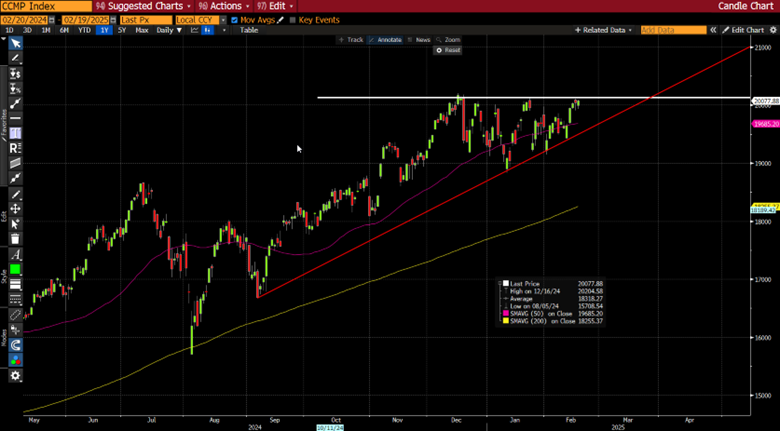Sitting in neutral — Week of February 17, 2025

| index | wtd | ytd | 1-year | 3-year | 5-year | index level |
|---|---|---|---|---|---|---|
| S&P 500 Index | 1.52 | 4.11 | 23.19 | 12.71 | 14.32 | 6,114.63 |
| Dow Jones Industrial Average | 0.65 | 4.89 | 16.97 | 10.60 | 10.87 | 44,546.08 |
| Russell 2000 Small Cap | 0.05 | 2.33 | 12.09 | 4.65 | 7.59 | 2,279.98 |
| NASDAQ Composite | 2.60 | 3.76 | 26.80 | 13.24 | 16.45 | 20,026.77 |
| MSCI Europe, Australasia & Far East | 2.66 | 8.33 | 12.89 | 6.30 | 7.08 | 2,456.76 |
| MSCI Emerging Markets | 1.54 | 4.81 | 14.90 | 0.07 | 3.16 | 1,130.61 |
| Barclays U.S. Aggregate Bond Index | 0.19 | 1.12 | 4.15 | -0.65 | -0.48 | 2,213.44 |
| Merrill Lynch Intermediate Municipal | -0.24 | 0.72 | 2.09 | 1.21 | 0.85 | 320.24 |
As of market close Friday, February 14, 2025. Returns in percent.
Investment Insights
— Steve Orr
At a Glance:
- Global economy bottoming; U.S. steady second gear
- Government runs out of money March 14; expect D.C. drama.
- Spending cuts, debt ceiling, pass budget in that order.
- Earnings solid +16.9%; 2025 growth marked lower.
- Bonds trapped in a trading range — waiting on tariffs, inflation.
Go around
If the stadium parking lot is a bit too crowded, we usually go around the stadium looking for another lot. If airliners find their destination backed-up, they are told to enter a holding pattern. Judging from recent market action, one could be forgiven for thinking markets are going around in circles, getting nowhere. Halfway through the first quarter (already?), down days have garnered more attention than ups. Despite the news noise, both the NASDAQ and S&P 500 have posted more up than down days. Still, going up and down in a narrow range is a better place to be than a grinding recession-led Bear.
The only other major index winning the up-down war is the MSCI Emerging Markets, with a record of 8 to 3. China has been the big driver in the EM index, rising some 14% this year. A good portion of the run is thanks to the Communist Party’s ongoing stimulus efforts to recover from the self-imposed housing bubble. The rally over the past couple of weeks in both developed and emerging markets has also been helped by the dollar’s 2% decline against its major trading partners. We have tariff talk to thank for that slide.
Holding pattern
If stocks are circling around highs, then bonds are stuck in the middle of their recent travels. Last September, the 10-year Treasury bottomed just before the Fed started cutting rates. The September 16 close of 3.62% was the lowest yield since May 2023. Since that low, 10s have made three runs higher: 5% in the fall of ’23, 4.70% in April and 4.79% most recently in January. Note that each of these runs was accompanied by fears of increasing supplies of Treasuries thanks to more spending by Congress.
Dodging DOGE
Fans of big government have had a rough couple of weeks. It seems to us that about once per decade the fad of cutting government waste and increasing efficiency comes to a boil. We like to think most of our readers are somewhere near their 40s in age. If that is the case, then let’s stick with the “in your lifetime” timeframe. President Reagan famously created the “President’s Private Sector Survey on Cost Control” in 1982. The group would conduct “an in-depth review of the entire Executive Branch and make recommendations for eliminating waste and inefficiency.” The group became known as the Grace Commission, after its Chair, businessman J. Peter Grace. The Commission’s report contained over 2,000 specific recommendations. We cannot recall any ever being implemented. In fact, the Reagan Library states, “especially those requiring legislation from Congress, were never implemented.”
In 1993, President Clinton went after the same problems. In a March 1993 speech, he recognized then-Texas Comptroller John Sharp’s (gig ‘em) efforts at the state level to tackle waste and how he wanted to do the same in D.C. As with Reagan, Clinton’s team took six months to “conduct an intensive national review of every single government agency and service.” Again, finding changes from their recommendations is at best difficult. Clinton did sign HR 3345, the Federal Workforce Restructuring Act of 1994. This act created buyouts for federal employees of up to $25,000. There are claims that the effort reduced the federal workforce by 300,000-plus, but it is not clear if those were all separations or partly unfilled jobs.
In 2006, President Bush signed the Federal Funding Accountability and Transparency Act. Its goal was to create a website that lists every grant and contract of the Federal government. Tom Coburn, noted spending critic, and Barack Obama, the junior senator from Illinois, were co-sponsors. The legislation created the “ExpectMore,gov” website. The website apparently lasted into the Obama administration.
Jumping into the next decade, President Obama continued the fight in 2011 by launching the Government Accountability and Transparency Board. This was part of the Campaign to Cut Waste, focusing on “rooting out misspent tax dollars and making government spending more accessible and transparent….” Again, results are tough to find. Anyone notice a trend here?
One element of the Obama campaign centered on improving and government software. He created an Executive Branch department called the United States Digital Service. Trump renamed this department the U.S. DOGE Service and expanded its role from evaluating software to reviewing payment systems. He also wanted to expand the staff and bring in Elon Musk. He could do this under 5 USC 3161, which allows for a temporary organization under the President. Under the Executive Order, DOGE wraps up its recommendations and ceases operation on July 4, 2026. DOGE has no authority to change anything, just make recommendations. A common thread among all these efforts is that they began with executive orders and made recommendations, and then Congress had to act to cut spending. Well, maybe this time it’s different.
Almost 17
Federal spending post-shutdown has kept the oft-called-for recession at bay. Our economy appears to be chugging along in second gear, toward a 2% to 2.25% real growth this quarter. Steady as she goes would be fine by us. Two percent plus growth in the economy has helped S&P 500 members notch a 16.9% gain in fourth quarter earnings versus 2023. FactSet reports that 77% of the big index members had reported through last Friday. The fourth quarter earnings growth is on track to be the best since the fourth quarter of 2021. Consumer Discretionary, Communication Services (internet) and Financials sectors have posted the largest earnings surprises. No surprise that Energy brings up the rear with double digit declines, thanks to difficult moves in crude prices last quarter.
Second, volume on the exchanges and big indices has noticeably slid lower since the start of the month. Only the S&P 500 has flirted with new highs this season; the rest of the big- and small-cap crowds are either in narrow channels or like the NASDAQ below, in a rising wedge.
Two items catch our attention this earnings season. First, we had looked askance at 15%+ earnings growth for the full year 2025. Weary readers will recall our bottoms-up build to the 9% area for the year. Over the past two weeks, companies have guided Wall Street lower in their outlooks. The Street has dutifully marked full-year forecasts down into the high 10% area. We expect continued tariff and geopolitical uncertainty to put downward pressure on that number.

The NASDAQ has not made a new high since November. The white line at 20,077 represents solid resistance. Note that each low is higher than the last, walking up the red uptrend line. There will have to be some event or spark to get traders out of this triangle. Perhaps NVIDIA’s earnings on February 26? Declining volume and an inability to break higher near all-time highs suggests to us there will be a bumpy ride in the coming weeks. Volatility index rolls over on February 19 and monthly options and futures expire on the 21st.
Wrap-Up
We are not prone to getting very excited about the latest thing. Our Xbox 360 seems to boot up when we press the “on” button. Scrounging batteries for the Motorola Flip phone has become an issue. Although the headlines are impressive, we will wait to see if Congress actually acts on any of the latest Presidential group findings. On average, the economy grows right around 2.5%, near what it is growing today. Earnings have been a pleasant surprise, bolstered by a stronger dollar over the past year, and moderation in commodity prices. Our indicator dashboard remains several shades of green, and we are staying fully invested in stocks.
Steve Orr is the Managing Director and Chief Investment Officer for Texas Capital Private Bank. Steve has earned the right to use the Chartered Financial Analyst and Chartered Market Technician designations. He holds a Bachelor of Arts in Economics from The University of Texas at Austin, a Master of Business Administration in Finance from Texas State University, and a Juris Doctor in Securities from St. Mary’s University School of Law. Follow him on Twitter here.
The contents of this article are subject to the terms and conditions available here.
Texas Capital Private Bank™ refers to the wealth management services offered by the bank and non-bank entities comprising the Texas Capital brand, including Texas Capital Bank Private Wealth Advisors (PWA). Nothing herein is intended to constitute an offer to sell or buy, or a solicitation of an offer to sell or buy securities.
Investing is subject to a high degree of investment risk, including the possible loss of the entire amount of an investment. You should carefully read and review all information provided by PWA, including PWA’s Form ADV, Part 2A brochure and all supplements thereto, before making an investment.
Neither PWA, the Bank nor any of their respective employees provides tax or legal advice. Nothing contained on this website (including any attachments) is intended as tax or legal advice for any recipient, nor should it be relied on as such. Taxpayers should seek advice based on the taxpayer’s particular circumstances from an independent tax advisor or legal counsel. The wealth strategy team at PWA can work with your attorney to facilitate the desired structure of your estate plan. The information contained on this website is not a complete summary or statement of all available data necessary for making an investment decision, and does not constitute a recommendation. The information has been obtained from sources considered to be reliable, but we do not guarantee that the foregoing material is accurate or complete. Any opinions are those of the authors and not necessarily those of PWA or the Bank.
©2025 Texas Capital Bank Wealth Management Services, Inc., a wholly owned subsidiary of Texas Capital Bank. All rights reserved.
Texas Capital Bank Private Wealth Advisors and the Texas Capital Bank Private Wealth Advisors logo are trademarks of Texas Capital Bancshares, Inc., and Texas Capital Bank.
www.texascapitalbank.com NASDAQ®: TCBI